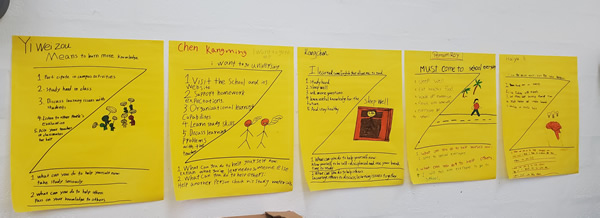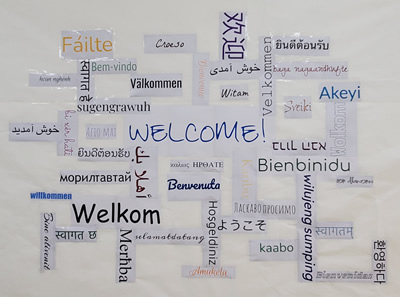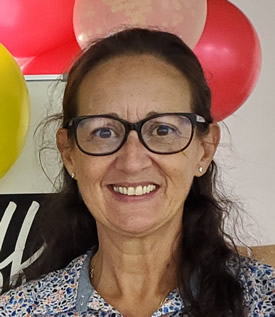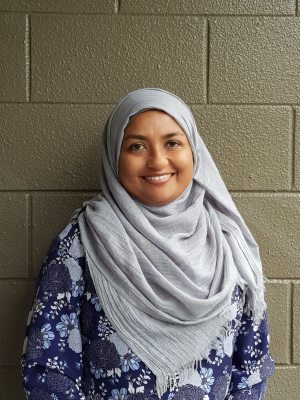Meet the Teacher: 7 Questions for Marcelle Monchanin
Meet the Teacher interviews spotlight teachers from all curriculum areas and levels who work toward supporting multilingual language learners. In this interview, I chat with Marcelle Monchanin who teaches English at Hopwood Middle School on the tiny island of Saipan, part of the Northern Mariana Islands.
Marcelle was born and raised in Florida. She graduated cum laude from the University of South Florida with a BA in general studies with a dual concentration in public health administration and information architecture. Later, she earned her MEd in TESOL from the same university. Born to a French mother and a Cuban father, Marcelle closely identifies with French and Cuban languages and cultures. Through her marriage, she was introduced and exposed to the languages and cultures of the Middle East, where she lived for nearly 10 years.
How did you first become interested in supporting English learners (ELs)?
My journey as a teacher began back in 2002 when we moved to Saudi Arabia as a family. While enrolling my children into a private elementary school in Jeddah, the school principal was observing us. She later said she was “moved” with the way I was communicating with my children about their entrance exam results, and “recognized something special” about the way I interacted with my children. She told me that it was “what she had wished for in all of her teachers, but didn’t always get” and immediately offered me a job as a teacher in her school. I was surprised! But, while I had no formal teaching experience then, I accepted. It was amazing and I loved it!
Spending that first year with 25 six- and seven-year-olds was an incredibly positive time of discovery, learning about myself, my own children, and my students.
What are your priorities in teaching students who are new to learning English, and perhaps new to the country?
One of my most important priorities is to make my students feel welcome and wanted in my classroom and our school. Learning cannot take place where there are feelings of mistrust, anxiety, shame, exclusion, embarrassment, or uncertainty. Therefore, my first goal is to make sure that any feelings that interfere with the learning process are recognized, understood, and resolved through replacing any negativity with positive reinforcements and feelings that promote a healthy relationship between my students and myself.
Another contending priority is making sure that ELs have access to quality grade-level instruction that meets their needs. The English Language Learner Program is fairly new at our school and involves the collaboration of the school community. We work together throughout the process, starting from student registration to lesson planning and even on to the two-year follow-up for all of our EL students who graduate from middle school.
Give us some examples of how you center the voices and experiences of your multilingual students.
One way I do this is by allowing them the free use of their home language. Some teachers may restrict the use of the student’s home language in the classroom, but I quickly recognized that when you limit or restrict something from a child, they may not always know or understand the purpose behind the limitation or restriction and this could cause the student to feel as if they are being left out of the process, causing anxiety. By including them in the learning process, you have just empowered students to make their own connections to actions, consequences, and results.
I also love to spend time getting to know my students. Right from the beginning, it is important to me that I pronounce their names correctly and learn about any prior classroom customs and learning experiences. I use the opportunity to include the information in our creation/updating of classroom rules. When the students are involved, they understand and grasp the purpose of the collaboration and end goal.
In what ways does your classroom environment reflect the languages and cultures of all your students and the cultures of the wider community?
Our school campus here in Saipan was nearly destroyed during the 2018 typhoon Yutu. With more than 50% of our school buildings damaged beyond repair, teachers share classrooms and we have gone to double sessions. While it is being rebuilt, my current space is limited, but my walls are filled with amazing student work!

I currently have Z charts on my walls from my after-school credit recovery students. I also always display a homemade word cloud with “Welcome” displayed in as many as 50 languages. The display is about 48” x 48”. My students love to find their respective languages on the display, and their faces light up! It is as if they expected not to find their languages on the display and have now been pleasantly surprised. It gets me every time.

What are your primary challenges in teaching students from diverse language and cultural backgrounds?
One of the challenges that immediately rises to the surface is the language barrier, but next is cultural differences. Being an EL teacher in this part of the world has introduced me to many different cultures and languages. Teaching a student who speaks a different language introduces me not only to their language, but to their culture and how the student relates to adults in their respective cultures and how that could affect me as their teacher.
When cultural differences exist, it takes more effort to build a trusting relationship with students. It takes trust to be vulnerable and let others know you need and want help. It comes down to building trust as my biggest challenge; once there is trust, the real work begins. With continuity and consistency, students begin to relax and to trust as they build self-confidence.
In what ways do you work with others in your school community to address those challenges?
I work closely with our administrative staff, teachers, librarian, and Title I coach to address the needs of all our students. I am currently training our teaching staff on the SIOP model and teaching method. We all work together to help and teach in the best way possible. We have teachers from multiple cultural backgrounds, and that helps me when I encounter a student of the respective cultures and languages. Students feel an instant connection when they find out someone at our school speaks their language. It truly is a team effort!
What advice do you have for other teachers in supporting multilingual learners?
Take the time to get to know your EL students. They bring with them as many years of experience and knowledge as the rest of your students; only, they have it all packed away in their brains in another language. Create a classroom environment where your students want to come and tell you what they learned, what they saw, what they heard, and what they think…even if they have to use a translation device.
The key is to figure out how to get students to bring out what is packed away and connect it to what is being presented as new experience and knowledge. When you can get them to understand that this is how they will grow academically and linguistically, that is the connecting a-ha! moment, and it is then that you will see them begin to grow wings and fly!
Would you like to share your experience of working with multilingual learners? Comment below on strategies that have worked for you. Or, if you would like to be interviewed, get in touch! You can reach me at n.mohamed@auckland.ac.nz.


